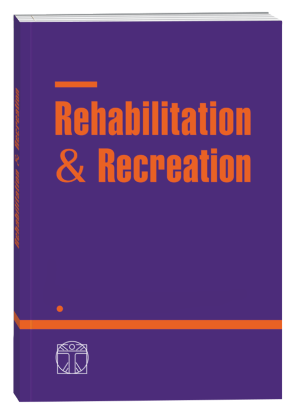POSSIBILITIES OF PHYSIOTHERAPEUTIC CORRECTION OF THE MOBILITY OF LARGE JOINTS OF THE LIMBS AND REDUCING THE FREQUENCY OF ACUTE TRAUMA
DOI:
https://doi.org/10.32782/2522-1795.2023.16.18Keywords:
physiotherapeutic correction, injury, post-isometric relaxation, post-load recovery, track and field athletes, overtraining, chronic overload.Abstract
Postisometric relaxation (PIR) is considered an effective method of increasing joint range of motion. These exercises improve the performance of athletes, reduce the frequency of injuries associated with their activities. This article describes the effects of specially selected post-training PIR exercises on the physical performance of track and field athletes, quality of recovery, risk of injury and range of motion in large joints, as well as physiological mechanisms, with the aim of investigating, analyzing and interpreting acute physical responses to a variety of PIR techniques. to provide clarity on the impact on performance, range of motion and incidence of injury. The purpose of the article is to evaluate the effectiveness of the proposed method of postisometric relaxation on the range of motion in the large joints of the upper and lower limbs and reducing the frequency of acute injuries. Material and results. The examination of track and field athletes was conducted at the center of sports medicine of Sumy State University from September to December 2022. To determine the range of motion in the joints of the upper and lower limbs and to study the possibilities of correction and recovery, we selected 40 practically healthy track and field athletes. 19 women were examined, 21 men. The average age of examined women was 17.5 years, men – 19.1 years. The research was conducted according to the principles of bioethics and deontology. All research participants agreed to participate in the survey. We performed goniometry of the joints of the upper and lower limbs before and after the introduction of specially selected post-isometric relaxation exercises. Goniometry was performed on such joints as the shoulder, elbow, wrist, hip, knee, and ankle. Conclusions. The application of the proposed method of postisometric relaxation as active recovery was accompanied by positive dynamics in most indicators of joint mobility of both upper and lower extremities (about 80 % of indicators p ˂ 0.001), a decrease in the frequency of injuries (in the one-month period before the examination, the frequency of injuries was 38 % (15 people), then only 15 % (6 people), p = 0.022); the average intensity of pain in injuries before the application of the PIR complex was 2.9 (0.71) points, and after – 1.5 (0.6) points, p ˂ 0.001.
References
Behm D.G., Blazevich A.J., Kay A.D., McHugh M. Acute effects of muscle stretching on physical performance, range of motion, and injury incidence in healthy active individuals: a systematic review. Appl Physiol Nutr Metab. 2016. Jan. Vol. 41(1). P. 1–11. doi: 10.1139/apnm-2015-0235
Bailey L.B., Thigpen C.A., Hawkins R.J., Beattie P.F., Shanley E. Effectiveness of Manual Therapy and Stretching for Baseball Players With Shoulder Range of Motion Deficits. Sports Health. 2017. May/Jun. Vol. 9(3). P. 230–237. Epub 12 Apr. 2017. doi: 10.1177/1941738117702835
Iwata M., Yamamoto A., Matsuo S., Hatano G., Miyazaki M., Fukaya T., Fujiwara M., Asai Y., Suzuki S. Dynamic Stretching Has Sustained Effects on Range of Motion and Passive Stiffness of the Hamstring Muscles. J Sports Sci Med. 2019. Feb. 11. Vol. 18(1). P. 13–20.
Peake J.M., Neubauer O., Della Gatta P.A., Nosaka K. Muscle damage and inflammation during recovery from exercise. J Appl Physiol. 2017. Mar. 1. Vol. 122(3). Р. 559–570. doi: 10.1152/japplphysiol.00971.2016
Steuri R., Sattelmayer M., Elsig S., Kolly C., Tal A., Taeymans J., Hilfiker R. Effectiveness of conservative interventions including exercise, manual therapy and medical management in adults with shoulder impingement: a systematic review and meta-analysis of RCTs. Br J Sports Med. 2017. Sep. Vol. 51(18). Р. 1340–1347. doi: 10.1136/bjsports-2016-096515
Tahran Ö., Yeşilyaprak S.S. Effects of Modified Posterior Shoulder Stretching Exercises on Shoulder Mobility, Pain, and Dysfunction in Patients With Subacromial Impingement Syndrome. Sports Health. 2020. Mar/Apr. Vol. 12(2). Р. 139–148. doi: 10.1177/1941738119900532
Van Hooren B., Peake J.M. Do We Need a Cool-Down After Exercise? A Narrative Review of the Psychophysiological Effects and the Effects on Performance, Injuries and the Long-Term Adaptive Response. Sports Med. 2018. Jul. Vol. 48(7). Р. 1575–1595. doi: 10.1007/ s40279-018-0916-2
Downloads
Published
How to Cite
Issue
Section
License

This work is licensed under a Creative Commons Attribution-NonCommercial-NoDerivatives 4.0 International License.











